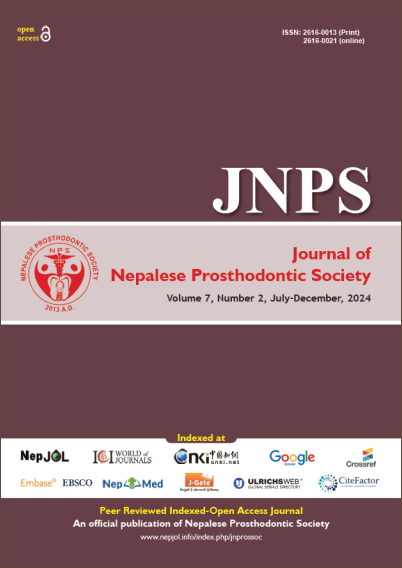Self-perceived Preparedness of Undergraduate Dental Students of a Dental College in Performing Various Dental Procedures
DOI:
https://doi.org/10.3126/jnprossoc.v7i2.77553Keywords:
Dental Students, Dental Procedures, Preparedness, Self-perceivedAbstract
Introduction: The transition from undergraduate dental student to actual dental practice is a crucial but challenging step. Dental graduates should feel well prepared to effectively perform clinical tasks even in an unsupervised context. Keeping in mind that the conditions under which the student works are different from the conditions of their future practice, confidence is considered a keystone for successful achievement and will no doubt reflect on their professional, clinical and management skills.
Objective: The aim of this study was to assess self-perceived preparedness of undergraduate dental students in Kathmandu Medical College and Teaching Hospital, Nepal.
Methods: A self-administered questionnaire form including well-validated, self-administered Dental Undergraduates Preparedness Assessment Scale (DU-PAS) was distributed to final year BDS students and interns of Kathmandu Medical College and Teaching Hospital, Nepal. Data were collected and entered into the Microsoft Excel sheet and analysis was done using Statistical Package of Social Sciences (SPSS) software version 20. Independent t test was used to determine the mean difference between males and females in self-perceived preparedness.
Results: A total of 80 participants, comprising final year dental students, interns, and dental surgeons from Kathmandu Medical College and Teaching Hospital (KMCTH), Nepal, took part in the study. The participants' ages ranged from 21 to 35 years, with a mean age of 25.14 years (SD 1.95). The majority of the participants were female (43.8%) and unmarried (87.5%) The total scores obtained by the respondents ranged from 44 to 90, with a mean score of 67.34 (SD 10.77).
Conclusion: The preparedness of undergraduate students of KMCTH was comparable to students of other countries. The data showed the participants felt prepared for the majority of the attributes expected from a dentist but there is need for improvements in the teaching and learning of dental students in the KMCTH to address gaps in their clinical skills and behavioral attributes.
Downloads
Downloads
Published
How to Cite
Issue
Section
License
Copyright (c) 2024 The Author(s)

This work is licensed under a Creative Commons Attribution-NonCommercial-NoDerivatives 4.0 International License.
This license enables reusers to distribute, remix, adapt, and build upon the material in any medium or format, so long as attribution is given to the creator. © The authors




